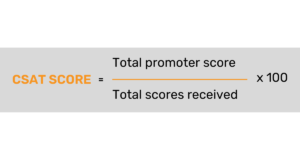CSAT stands for Customer Satisfaction Score, and it measures how satisfied your customers are with your product or service. This is one of the most commonly used satisfaction metrics that measures how happy or unhappy a user may be, with certain products or services. In this blog, we will explore what is the CSAT metric, how it is measured and the role of CSAT in various touchpoints.
What Is Customer Satisfaction Survey and How Is It Measured?
CSAT is short for Customer Satisfaction, a metric that gauges how satisfied the users are with a product or service. This is typically measured through surveys given via in-app surveys, dynamic emails and via chatbots deployed on websites. Analyzing feedback results and making changes accordingly can improve CSAT scores.
Benefits of tracking CSAT scores
Tracking CSAT scores has several advantages for businesses. It helps them gain insights into the satisfaction level of their entire customer base. Additionally, it provides valuable feedback on specific experiences and expectations that customers have had with the business. CSAT scores can identify detractors, promoters and people who fall under the neutral category (passives). Customer insights obtained from these surveys can be used to improve customer service and retention rates while reducing churn. Regularly tracking CSAT scores can help businesses stay competitive by staying attuned to customer needs and preferences.
Improve customer satisfaction and loyalty
Regularly monitoring CSAT scores helps businesses identify areas of improvement in their products or services. This falls under the continuous development protocols for any organisation. It also allows them to evaluate the effectiveness of their customer service training programs while measuring overall customer sentiment. The benefits of focusing on improving CSAT scores contribute to better retention rates, increased revenue, and growth.

Reduce churn rate and identify detractors
One way to reduce churn is to pinpoint detractors earlier on. They may have had an unpleasant experience during a transaction. This will be evident in the customer satisfaction survey scores. The support team or the respective department can call a customer to gain open-ended, verbal insights to understand why a user might have felt the brunt of a negative experience. CSAT score is a standardized manner of understanding if patrons are satisfied with certain products, services or overall experience.
CSAT Metrics vs. NPS and CES
CSAT metrics are an essential tool for measuring customer satisfaction levels after specific interactions with a company. NPS is a net promoter score which seeks feedback based on recommendation of a product. It focuses on overall customer loyalty, enthusiasm and satisfaction. CES is a customer effort score which is very different from both the metrics. CES gauges the effort a consumer will take during a certain interaction or while on a process- it could be during a transaction, purchase, understanding a product demo or on a call with a support team member. CSAT is different from NPS and CES and used to gauge specific feedback.
Additionally, using CSAT metrics in conjunction with other valuable feedback channels like dynamic email, in-app surveys, websites, social media platforms etc. can help businesses gain valuable insight into a customer’s sentiment or a delight factor.
While this a closed-ended metric like NPS and CES, this scale can also seek open-ended qualitative feedback such that users can mention more vivid details about an experience.
When to use each metric for feedback?
Three key metrics to consider are CSAT, NPS, and CES.
CSAT measures short-term satisfaction levels after specific interactions with a company, NPS gauges overall loyalty and advocacy. CES focuses on how easy or challenging interactions are for customers. Incorporating these metrics into regular surveys can provide valuable feedback for improving CX, retention rates, and churn rates without sacrificing user sentiment or effort.

How to calculate a CSAT score
A CSAT survey is as simple as follows: “How satisfied were you with your recent interaction?”. This is followed by various scales ranging from ‘highly unsatisfied’ to ‘highly satisfied’. it’s important to calculate a good CSAT score by taking into account industry benchmarks and customer expectations.
To calculate the CSAT score, count the number of satisfied customers (promoters who rated you in the 4 and 5 category). Divide the total number of (promoter) respondents by the overall total responses received. For example, if you received 150 responses from promoters from a total of 200 responses, your score will be 75.
Customer Satisfaction Surveys Across Touchpoints
Measuring customer sentiment through customer satisfaction surveys at specific touchpoints can detect pain points and obstacles.
Let us say we onboard a client into the business ecosystem. During onboarding, the satisfaction metric may have been the highest since it was the first time a user got to experience a product/ service. It cannot be taken for granted that the happiness indicator at one point will be even across the entire consumer lifecycle. Understanding the satisfaction score is a long term event. During different stages of the life cycle, the CSAT score can gauge if the brand has consistently delivered on the initial promise or there are pain points that a user has to go through.

Choosing the right touchpoints to maximize results
A touchpoint is a place where a customer comes in contact with the organization, their product or service, or even a support team. The future experience will be based on the feeling a user goes through, while using a product or a website. A customer could be surfing a website to purchase a product. The entire website interface may have facilitated the process. Since the purchase was seamless, a chatbot towards the end of a transaction might seek feedback. It might ask about the satisfaction metric with the entire process. While the website may have been a touchpoint, there can be other touchpoints such as during an application usage, satisfaction feedback after receiving a product, customer satisfaction metric after talking to a customer care executive etc.
How to Interpret and Act on CSAT Results
Making the most of your customer satisfaction survey involves interpreting and acting on the results correctly. Firstly, analyze the data to look at the overall score and drill down into individual touchpoints’ performance. Address negative feedback by identifying its root cause and taking corrective action. Continuously reviewing feedback results helps identify trends and make ongoing improvements to customer experience that keep satisfied customers happy while minimizing detractors.
Identifying trends and enhancing CX
Identifying trends can occur when there is a real-time tracking of responses, feedback and experiences. This can happen when customer satisfaction surveys are launched at various touchpoints. Capturing trends goes beyond seeking feedback. Trends can be based on expectations stemming out of certain behaviours, preferences and benchmarks among the user base. Capturing satisfaction metrics from every user can help businesses understand pain points, attend to them real-time and boost loyalty in the long run. CX is dependent on an overall effort a company makes to create a smooth journey for the people.
Communicating results to stakeholders
It is important to present both positive and negative feedback when communicating CSAT results with stakeholders. While positive responses are a reason to celebrate, negative feedback becomes a reason to scrutinize internal processes. Improvement is a continuous and a long term process. Consistently delivering a seamless CX can contribute to an overall success.
Evaluate CSAT metrics regularly on a daily basis using follow-up questions via interactive emails, Whatsapp surveys, telephonic calls to reach out to respondents while tracking the overall satisfaction level of your entire customer base. Effective communication with stakeholders can lead to happy customers who are more likely to be promoters.
Conclusion
For most customer satisfaction surveys , it is recommended that you offer to give an open ended response option. This will bring a more vivid feedback in the dashboard since a satisfaction metric may not be able to share the entire picture. Tagging along with a quantitative feedback, a qualitative feedback offers a space for a more dynamic and expressive response rate. One can curate CSAT surveys using interactive tools, emojis and color options.
To understand how Merren can expedite your customer feedback process, sign up for a 14 day free trial now.





